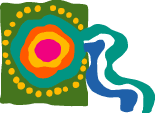
|

Aborigines have always been involved in trade. Prior to colonisation Aborigines had well-established networks of exhcange: itmes such as food and raw materials, ceremonial objects, ornaments and weapons were exchanged in addition to song, dance and ceremony.
When Europeans arrived, Aborigines sought to incorporate them within their own relations of reciprocity and indebtedness. Aborigines at Port Jackson for example traded desired items such as bread, blankets and items of clothing with visiting French, Russian and American explorers. These objects probably formed the basis of the first European collections of Aboriginal art.
|
|

Key concepts |
• art industry
• exploitation
• empowerment
|
|
|
| |
An Aboriginal art industry
From these humble beginnings, Aboriginal art is today embedded in a global industry. With over 10,000 Aboriginal artists on public record, most of whom live in remote communities, the Aboriginal art industry (currently estimated at A$30 million annually) represents an important economic return.
But, Aboriginal art continues to fulfill multiple roles. It represents a means of:
- transmitting cultural knowledge to a younger generation;
- gaining access to land rights; and
- educating Europeans about the values of Aboriginal culture.
|
|
|
 |
Read pp. 282-337 |
|
Artefact collections
Morphy traces the development of the Aboriginal art industry from an earlier era to the present day. During the 19th century the vast collections amassed by individuals such as Victorian R. E. Johns reflected a general fascination with weaponry. Such collections were assumed to be ethnographically authentic, but in all probability Johns collected contemporary artefacts that accorded with his conceptions of 'primitive art'.
Likewise the first collections of bark paintings from Oenpelli amassed by Baldwin Spencer for the National Museum of Victoria (now Museum Victoria) were viewed as artefacts, not art. Nevertheless, the bark paintings had been commissioned because Spencer was impressed by the aesthetic quality of Aboriginal art. |
|
|
| |
Craft production
In the 1940s and 1950s a tradition of craft production had emerged in Central Australia: pokerwork and watercolour landscapes at Hermannsburg, pokerworked animals and objects (punu) among the Pitjantjatjara people, while at Ernabella women produced drawings, printmaking, woollen rugs and batik. However, all these earlier art forms were overlooked perhaps because the art world favoured the fine arts over the crafts, which were traditionally associated with women's work. |
|
|
| |
New art, new audiences
A contemporary art industry evolved in 1970s through a timely coincidence of factors. Just as a new acrylic art movement emerged at Papunya driven by policies of self-determination and the growth of the outstation movement, the commonwealth government decided to support the development of an Aboriginal art industry. At the same time the new acrylic 'dot' painting movement created new audiences for contemporary Aboriginal art among state and private patrons thereby guaranteeing the success of the industry. |
|
|

| |
Does the Aboriginal art industry represent exploitation or empowerment? |
|
Benjamin: Exploitation or empowerment?
Controversies inevitably surround the Aboriginal art industry. Many purists argue that when Aborigines make art for sale the integrity of their work is compromised: in their eyes commodification necessarily involves exploitation and a capitulation to capitalism -'dots for dollars'.
Art historian Roger Benjamin contradicts this viewpoint pointing to the dynamism and diversity of Aboriginal art. Far from being exploited, Benjamin argues, it is the Aboriginal producers who strategically exploit the global art market. This is not to deny that problems exist: the status accorded individual artists, media scandals and the need for legislation protecting resale royalties (droit de suite), but these do not detract from the success of the industry.
|
|
|

| |
How has the Aboriginal art market evolved? |
|
Altman: The marketing of Aboriginal art
Contemporary Aboriginal art moves across a wide spectrum from the fine art world of unique art objects to the tourist souvenir purchased as 'airport art'. Anthropologist Jon Altman shows that the Aboriginal art industry is able to bridge the cognitive and cultural divide between these various contexts by:
- drawing support from government agencies and arts advocacy organisations; and
- marketing to national and state galleries and museums, commercial gallery dealers, private patrons and the wider public.
|
|
|
 |
Art for sale
Visit the following web sites selling Aboriginal art:
Sothebys
Collecting Aboriginal Art
Maruku Art & Craft
Ernabella
What did you find?
Is the outlet Indigenous owned?
Is there a difference between the range of art works sold by Sothebys for example and Maruku Art and Craft?
Talk about your findings on the Discussion Board. |
|
|
| |
 |
|
|
|
|